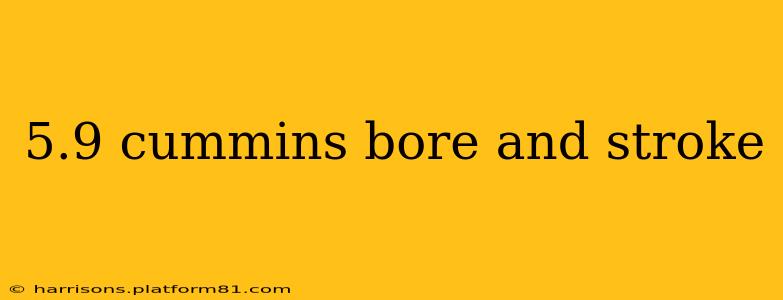The 5.9 Cummins, a legendary engine known for its reliability and power, boasts specific bore and stroke dimensions that contribute significantly to its performance characteristics. Understanding these dimensions is crucial for anyone working on, modifying, or simply appreciating this iconic engine. This article will explore the bore and stroke of the 5.9 Cummins, addressing common questions and providing valuable insights.
What is the bore and stroke of a 5.9 Cummins?
The 5.9 Cummins engine, officially designated as the B series, typically features a bore of 4.0 inches (101.6 mm) and a stroke of 4.72 inches (120 mm). These dimensions are critical because they directly influence the engine's displacement (or cubic capacity). The bore refers to the diameter of the cylinder, while the stroke describes the distance the piston travels within the cylinder.
How is the displacement calculated?
The displacement of the engine is calculated using a formula that incorporates the bore and stroke, along with the number of cylinders. For the 5.9 Cummins, which is a six-cylinder engine, the calculation is as follows:
Displacement = (π/4) * bore² * stroke * number of cylinders
Applying this formula:
Displacement = (π/4) * (4.0 inches)² * (4.72 inches) * 6 = 353.7 cubic inches (5.79 liters)
This is approximately 5.9 liters, hence the common "5.9 Cummins" designation. Slight variations might exist depending on the specific sub-model of the 5.9 Cummins engine, but these figures represent the typical values.
What are the implications of the bore and stroke?
The relatively long stroke of the 5.9 Cummins (compared to its bore) contributes to its significant torque output at lower RPMs. This makes it ideal for applications requiring high pulling power, such as heavy-duty trucks and industrial equipment. This long-stroke design contributes to the engine's reputation for durability and reliability under heavy loads.
Does the bore and stroke vary across different 5.9 Cummins models?
While the 4.0-inch bore and 4.72-inch stroke are typical, minor variations can occur depending on the specific model year and application of the 5.9 Cummins engine. These minor differences typically don’t significantly impact the overall displacement. However, if you're working on a specific 5.9 Cummins, always consult the engine's specifications for precise measurements.
How does the bore and stroke relate to engine performance?
The bore and stroke directly affect several aspects of engine performance:
- Displacement: As shown above, they determine the engine's total volume, which is directly related to power output.
- Torque: The long stroke of the 5.9 Cummins contributes to its high torque at lower RPMs.
- RPM: The stroke length also influences the engine's maximum safe RPM, impacting the overall power band.
Understanding the relationship between these factors is essential for optimizing engine performance for specific applications.
Are there any modifications that affect the bore and stroke?
Modifying the bore and stroke, such as through boring the cylinders or altering the crankshaft, is a complex process usually undertaken by experienced engine builders. Such modifications can significantly change the engine's characteristics, offering opportunities for increased power or efficiency, but also introducing potential risks if not performed correctly. These modifications often necessitate specialized tools, knowledge, and expertise, and should only be attempted by qualified professionals.
This detailed analysis provides a thorough understanding of the 5.9 Cummins bore and stroke, dispelling any ambiguity surrounding these key engine dimensions. Remember, always consult official service manuals and specifications for the specific 5.9 Cummins engine you are working with to ensure accurate information.
